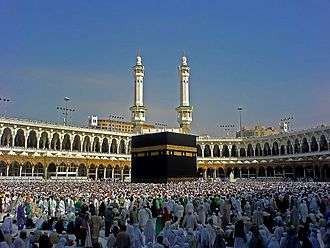Salat al-Janazah
Ṣalāt al-Janāzah (Arabic: صلاة الجنازة) is the Islamic funeral prayer; a part of the Islamic funeral ritual. The prayer is performed in congregation to seek pardon for the deceased and all dead Muslims.[1] The Salat al-Janazah is a collective obligation upon Muslims (farḍ al-kifāya) i.e., if some Muslims take the responsibility of doing it, the obligation is fulfilled, but if no-one fulfils it, then all Muslims will be accountable.[2]
Performing the funeral prayer when the body is not present is generally not permitted in the Hanafi and Maliki madhhabs, is permitted in the Hanbali madhhab, and is recommended in the Shafi‘i madhhab.
Description
It is preferable that those praying divide themselves into odd rows with one person as an imam standing alone in front and while facing the qiblah. The body is placed in front of the Imam. If there is more than one body, then these should be put one in front of the other. The spoken part of the prayer involves quietly reciting sura Al-Fatiha, then praying for God to bestow peace, mercy and blessings on Muhammad, and finally saying two du'as. There is no ruku in janazah prayer.[3]
Muhammad and his companions explained how the salah should be:[4]
- Having the appropriate neeyat (intention) in your heart, You say the first takbir while raising your hands, then you fold and hold your hands on your chest in the usual manner, the right hand on the left, then you seek refuge with Allah from the accursed Shayṭan, then you utter Bismillah and recite Al-Fatiha
- Then you say Takbir and Durood-i Ibrahimi.
- Then you say a third Takbir and make du'a for the deceased.
It is narrated that Muhammad said:
"O God, forgive our living and our dead, those who are present among us and those who are absent, our young and our old, our males and our females. O God, whoever You keep alive, keep him alive in Islam, and whoever You cause to die, cause him to die with faith. O God, do not deprive us of the reward and do not cause us to go astray after this. O God, forgive him and have mercy on him, keep him safe and sound and forgive him, honor his rest and ease his entrance; wash him with water and snow and hail, and cleanse him of sin as a white garment is cleansed of dirt. O God, give him a home better than his home and a family better than his family. O God, admit him to Paradise and protect him from the torment of the grave and the torment of Hell-fire; make his grave spacious and fill it with light."
- It is acceptable for other words to be used for du'a; for example, one could say:
O God, if he was a doer of good, then increase his good deeds, and if he was a wrongdoer, then overlook his bad deeds. O God, forgive him and give him the steadiness to say the right thing.
4. Then a fourth takbir is recited, followed by a short pause, then a final taslim to the right, saying "Assalaamu ‘alaykum warahmatullah" ("Peace and blessings of God be unto you").
Exceptions
According to an authentic hadith, Muhammad did not say the burial prayers of a person who committed suicide;[5]
Jabir b. Samura reported: [The dead body] of a person who had killed himself with a broad-headed arrow was brought before the Apostle of Allah, but he did not offer prayers for him. Another exception is for one who hasn't paid off debts until someone paid it on the deceased person's behalf.
References
- Nzomiwu, John Paul C. (13 April 1989). "The History and Message of Islam". Meks-Unique – via Google Books.
- Saqib, Muhammad Abdul Karim (13 April 2015). "A Guide to Salat (Prayer) in Islam". Salaam - Salah Vision – via Google Books.
- Sheikh Ramzy (2012). The Complete Guide to Islamic Prayer (Salāh). Author House. p. 143. ISBN 978-1-4772-1465-7.
- Kitaab Majmoo’ Fataawa wa Maqaalaat Mutanawwi’ah li Samaahat al-Shaykh ‘Abd al-‘Azeez ibn ‘Abd-Allaah ibn Baaz, vol 13, p. 141
- "Center for Muslim-Jewish Engagement". cmje.usc.edu.
External links
| Wikimedia Commons has media related to Salat al-Janazah. |
.jpg)
